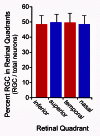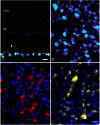Evaluation of the percentage of ganglion cells in the ganglion cell layer of the rodent retina
- PMID: 23825918
- PMCID: PMC3695759
Evaluation of the percentage of ganglion cells in the ganglion cell layer of the rodent retina
Abstract
Purpose: Retinal ganglion cells comprise a percentage of the neurons actually residing in the ganglion cell layer (GCL) of the rodent retina. This estimate is useful to extrapolate ganglion cell loss in models of optic nerve disease, but the values reported in the literature are highly variable depending on the methods used to obtain them.
Methods: We tested three retrograde labeling methods and two immunostaining methods to calculate ganglion cell number in the mouse retina (C57BL/6). Additionally, a double-stain retrograde staining method was used to label rats (Long-Evans). The number of total neurons was estimated using a nuclear stain and selecting for nuclei that met specific criteria. Cholinergic amacrine cells were identified using transgenic mice expressing Tomato fluorescent protein. Total neurons and total ganglion cell numbers were measured in microscopic fields of 10(4) µm(2) to determine the percentage of neurons comprising ganglion cells in each field.
Results: Historical estimates of the percentage of ganglion cells in the mouse GCL range from 36.1% to 67.5% depending on the method used. Experimentally, retrograde labeling methods yielded a combined estimate of 50.3% in mice. A retrograde method also yielded a value of 50.21% for rat retinas. Immunolabeling estimates were higher at 64.8%. Immunolabeling may introduce overestimates, however, with non-specific labeling effects, or ectopic expression of antigens in neurons other than ganglion cells.
Conclusions: Since immunolabeling methods may overestimate ganglion cell numbers, we conclude that 50%, which is consistently derived from retrograde labeling methods, is a reliable estimate of the ganglion cells in the neuronal population of the GCL.
Figures




References
Publication types
MeSH terms
Grants and funding
LinkOut - more resources
Full Text Sources
Molecular Biology Databases
Miscellaneous
